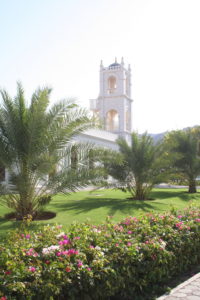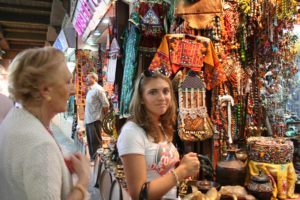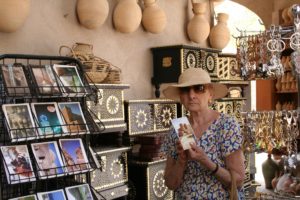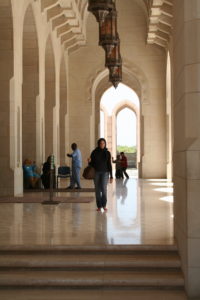In May 2010 my mum and grandmother came to visit me in the Middle East. I was able to only get a few days off, and decided to do something different with them. For the first couple of days the two ladies stayed in Dubai and explored this modern city and my mum showed my grandmother around, whilst I was at work.
We then met up in Dibba, a small border town between the United Arab of Emirates and the Peninsula Musandam that belongs to Oman, we rented a car to commence our short road trip to Muscat, the capital of the Sultanate of Oman. There are several options to drive to Muscat, but for nice scenic view through most northern part of the Al Hajar mountains we decided to cross the border at Hatta. Within 440km you can reach the capital of Oman, and besides the curving roads in the mountains, the road remains most of the time all straight and quite boring. The landscape remains very dry and desert-like throughout the drive along the coast. At this time of the year (May) it is very hot in Oman and temperatures can reach up to 40 degrees Celsius.
 Muscat is a beautiful city and low-lying white buildings typify most of Muscat’s urban landscape. The city lies on the Arabian Sea along the Gulf of Oman, and the rocky Western Al Hajar Mountains dominate the landscape of Muscat. The capital offers several must visit places and the best way to explore Muscat is by walking around.
Muscat is a beautiful city and low-lying white buildings typify most of Muscat’s urban landscape. The city lies on the Arabian Sea along the Gulf of Oman, and the rocky Western Al Hajar Mountains dominate the landscape of Muscat. The capital offers several must visit places and the best way to explore Muscat is by walking around.
One of these areas are “Old Muscat” which despite serving as the home of the ruling sultan, it retains the feel of a small and decidedly sleepy little town. At the heart of Old Muscat is the Sultan’s Al Alam Palace, the most important of the six royal residences of the ruling monarch, Sultan Qaboos. The palace isn’t open to the public, although you can get a good view of the façade from the iron gates at the front. Within Old Muscat there are various small museums scattered and one of the most interesting ones is “Bait al Zubair” with wide-ranging exhibits relating to Omani culture, customs and craftsmanship.
 The port-district of Muttrah, with its corniche and harbor, is the city’s old commercial center, and still one of the most interesting parts of the city. The area retains much of its mercantile importance thanks to the presence of the large docks, the fish market and the popular Muttrah Souk. The Muttrah Souk is also called Al Dhalam, which means ‘Darkness’ in Arabic, and is one of the oldest marketplaces in the Arab world due to its strategically location on the way to India and China. A walk on the promenade along the sea at sunset followed by a evening walk through the souk is quite stunning, and you can enjoy the vivid city by night. From the port you can admire one of the many forts around Muscat, the Muttrah Fort, which is located on top of a rocky and narrow hill. It is one of the reminders of its past from the old Portuguese, and in the evening illuminated.
The port-district of Muttrah, with its corniche and harbor, is the city’s old commercial center, and still one of the most interesting parts of the city. The area retains much of its mercantile importance thanks to the presence of the large docks, the fish market and the popular Muttrah Souk. The Muttrah Souk is also called Al Dhalam, which means ‘Darkness’ in Arabic, and is one of the oldest marketplaces in the Arab world due to its strategically location on the way to India and China. A walk on the promenade along the sea at sunset followed by a evening walk through the souk is quite stunning, and you can enjoy the vivid city by night. From the port you can admire one of the many forts around Muscat, the Muttrah Fort, which is located on top of a rocky and narrow hill. It is one of the reminders of its past from the old Portuguese, and in the evening illuminated.
 On our second day, we decided to drive inlands through the Western Al Hajar Mountains and after 160km we reached Nizwa, one of the oldest cities in Oman. In fact, Nizwa used to be the capital of Oman in the 6th and 7th centuries AD, and was once a center of trade, religion, education and art. Set amid a verdant spread of date palms it became a cente for date growing and a market place for the area. Today, Nizwa is diverse prosperous place with numerous agricultural, historical and recreational aspects. The main tourist attractions are the Nizwa Fort and the traditional Nizwa Souq. The Nizwa Fort was built in 1650s and is Oman’s most visited national monument. The fort is a powerful reminder of the town’s significance through turbulent periods in Oman’s long history.
On our second day, we decided to drive inlands through the Western Al Hajar Mountains and after 160km we reached Nizwa, one of the oldest cities in Oman. In fact, Nizwa used to be the capital of Oman in the 6th and 7th centuries AD, and was once a center of trade, religion, education and art. Set amid a verdant spread of date palms it became a cente for date growing and a market place for the area. Today, Nizwa is diverse prosperous place with numerous agricultural, historical and recreational aspects. The main tourist attractions are the Nizwa Fort and the traditional Nizwa Souq. The Nizwa Fort was built in 1650s and is Oman’s most visited national monument. The fort is a powerful reminder of the town’s significance through turbulent periods in Oman’s long history.  Quite impressive is also the Nizwa Souq, as this city is famous for its handicrafts and agricultural products and offers an expansive variety of products. It is also renowned for its silver jewelry, which is considered to be the best in the country. Additionally, they also make copper ware, coffee pots, swords, leather goods and pottery. It was a beautiful, sunny and very hot day, and here we learnt so much about the Omani culture. I have to admit that with 40 degrees Celsius that day, I had some blood pressure issues and felt dizzy at some points, whereas my 84 year old grandmother was walking around and handled the heat better than me. 🙂
Quite impressive is also the Nizwa Souq, as this city is famous for its handicrafts and agricultural products and offers an expansive variety of products. It is also renowned for its silver jewelry, which is considered to be the best in the country. Additionally, they also make copper ware, coffee pots, swords, leather goods and pottery. It was a beautiful, sunny and very hot day, and here we learnt so much about the Omani culture. I have to admit that with 40 degrees Celsius that day, I had some blood pressure issues and felt dizzy at some points, whereas my 84 year old grandmother was walking around and handled the heat better than me. 🙂
 The following day before heading back North towards Musandam, we stopped at the Sultan Qaboos Grand Mosque. Opened in 2001, this is the only mosque in Oman open to non-Muslims and one of the largest in the Gulf, with room for estimated 20,000 worshippers in the two prayers halls and surrounding courtyards. The mosque itself sits within a walled compound with a minaret at each corner, plus a fifth, larger minaret halfway along the northern wall. The main prayer hall is covered with a the world’s second largest carpet, which took 400 female weavers from Iran four years to make – the whole thing measures 60 x 70 m, contains 1.7 million knots and weighs 21 tonnes. The huge Swarovski crystal chandelier in the center of the hall is 14m tall and was claimed to be the largest in the world until the construction of an even bigger one. Visiting the Grand Mosque in Muscat is a must-do, as it is indeed stunning and leaves you speechless.
The following day before heading back North towards Musandam, we stopped at the Sultan Qaboos Grand Mosque. Opened in 2001, this is the only mosque in Oman open to non-Muslims and one of the largest in the Gulf, with room for estimated 20,000 worshippers in the two prayers halls and surrounding courtyards. The mosque itself sits within a walled compound with a minaret at each corner, plus a fifth, larger minaret halfway along the northern wall. The main prayer hall is covered with a the world’s second largest carpet, which took 400 female weavers from Iran four years to make – the whole thing measures 60 x 70 m, contains 1.7 million knots and weighs 21 tonnes. The huge Swarovski crystal chandelier in the center of the hall is 14m tall and was claimed to be the largest in the world until the construction of an even bigger one. Visiting the Grand Mosque in Muscat is a must-do, as it is indeed stunning and leaves you speechless.
We could have easily stayed more days in Muscat, as there is a lot more to see within the city and the surroundings. Muscat also offers some great beach resort e.g. the Chedi, Shangri-La Barr Al Jissah, or Al Bustan Palace, just to name a few.
However, our short mainland Oman trip ended here, as we then headed back to Musandam to spend our last couple of days relaxing at the Six Senses Resort. Obviously, I couldn’t miss out showing my grandmother as well where I work, and after extensive days of sight seeing in Dubai, Muscat and Nizwa even my granny was looking forward to swimming and spa-time. I made sure that the two elderly ladies were spoilt rotten at the resort indulging in the best foods and spa treatments.
I have to admit that Oman in general has surprised me entirely: it’s culture and especially its people. Omanis are such warm, kind, friendly and welcoming people that any foreigner immediately feels like at home. They totally try to go all the way to ensure you feel comfortable and welcome by everyone. Even it is a Muslim country, they are very curious to learn and are open towards the Western cultures, which may have something do with the Sultan Qaboos himself. He has completed his education and studies in Britain and as well served in the British Army in the 1960s. The country is very unique and is still not yet overrun by too many tourists like other Arab countries / cities, giving you an authentic cultural view. Here are a few impressions from our trip, and start planning your next holiday to Oman. I can guarantee it is worth while!